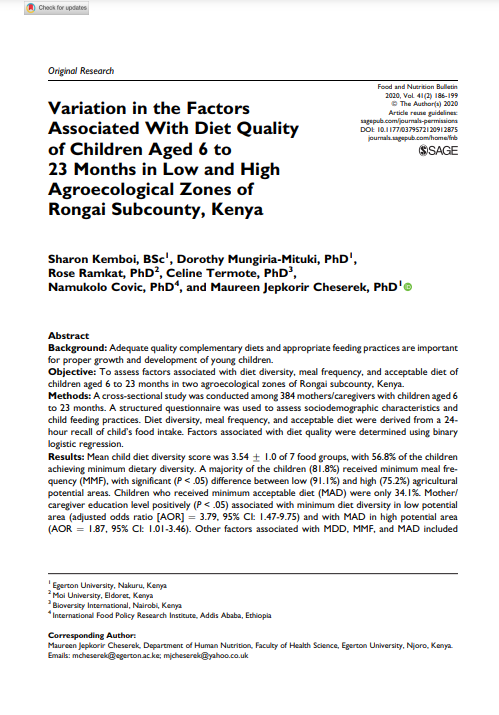Many developing countries are still facing the problem of malnutrition, especially among children younger than 5 years. Globally, 22.9% of children younger than 5 years are stunted and 7.7% are wasted. In Kenya, the national level of stunted, underweight, and wasted children is currently at 26%, 11%, and 4%, respectively.
Children below 2 years are particularly a vulnerable group since inadequate nutrition during this period is associated with growth faltering, increased risk of morbidity and mortality, impaired motor and cognitive development, reduced educational attainments, and social capacities. The first 1000 days of a child’s life is an important period for growth and development where much growth faltering takes place during the complementary feeding period (gradual introduction of soft and semisolid foods alongside breast milk) at age 6 to 23 months. Inappropriate complementary feeding practice is a major factor contributing to inadequate nutrient intake among infants and young children.
Complementary feeding practices have been associated with factors such as maternal knowledge on complementary feeding, child’s age, access to postnatal health-care services, and maternal busy schedules. However, specific patterns and contexts within particular communities need to be better understood.
Consuming a diverse diet increases the possibility of adequate intake of essential nutrients. However, in Kenya, traditional diets fed to infants and young children during the complementary feeding period are characteristically based on starchy staples with little or no nutrient-rich food sources such as animal source protein, fruits, and vegetables.
Mothers/caregivers’ lack of nutrition knowledge and their feeding attitudes have been identified as predictors of a child’s meal frequency and diet diversity. In our previous work in Rongai subcounty, we found that mothers/caregivers consumed poor quality diets despite diversity of food in their farms, suggesting lack of knowledge on locally available nutrient-rich foods and the best ways to utilize them in diet. This may have implications on quality of diets given to the children.
Minimum dietary diversity (MDD) for children is defined as consumption of at least 4 of the 7 food groups recommended by World Health Organization (WHO).Although consuming a variety of foods increases the chances for provision of diverse nutrients, meal frequency is equally important in order to attain an acceptable diet for children.
Children aged 6 to 23 months should receive complementary foods 2 to 4 times a day with 1 or 2 snacks as the desired minimum meal frequency (MMF). Meeting the MDD requirement together with the stipulated MMF contributes to achieving a minimum acceptable diet (MAD). In Kenya, 41% of children attained MDD, with 51% meeting the MMF requirement and consequently only 22% achieved MAD. Clearly, meeting both the MDD and MMF requirements concurrently seems to be a limiting factor of diet quality that needs to be addressed.
Improving mother/caregivers’ child feeding practices such that they observe attainment of both MDD and MMF requirements can contribute to improving the quality of complementary diets. Therefore, it is vital to understand how mother/caregivers’ child feeding practices influence the diet diversity, meal frequency, and subsequently acceptable diet of children aged 6 to 23 as these may vary from region to region. This would be an important input to developing contextualized interventions that are based on prevailing child feeding practices instead of generalized interventions that may not relate well to the context.
Different agroecological zones have been identified to contribute to variation in diets of children. The variation in diet diversity was observed across agroecological zones in Nepal, while in rural Ethiopia, differences in MDD, MMF, and MAD were reported in lowland and midland agroecological zones. However, adequate research has not been done to further explore such occurrence in Kenya.
Therefore, the objective of this study was to determine how mother/caregiver characteristics and child feeding practices influence diet quality of children aged 6 to 23 months in 2 agroecological zones (low and high agricultural potential areas) of Rongai subcounty in Nakuru County, Kenya.
Kemboi, S.; Mungiria-Mituki, D.; Ramkat, R.; Termote, C.; Covic, N.; Cheserek, M.J.

